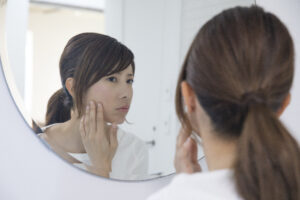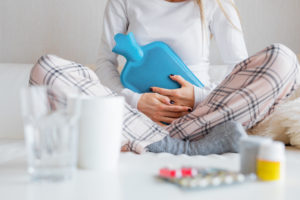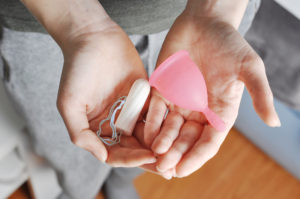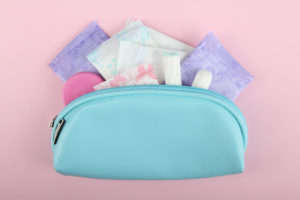By Iris Farrou
13 Jan, 2023
Menstruation, Prevention, Queer Health, Reproductive health, Sexual health, Women's Health
Abnormal Discharge, Ph Balance, vaginal discharge, Vaginal Odors, When to See a Gynecologist, yeast infection

Let’s get one thing out of the way: all vaginas produce some odor, and this odor varies through your menstrual cycle and through life’s activities. For example, you are more likely to experience a stronger smelling vaginal discharge if you are mid-cycle, after intercourse, or after a workout. However, if there is an unfamiliar, strong, and unpleasant odor that persists for several days that is cause for concern and should be checked out ASAP. If it is accompanied by other symptoms like grayish vaginal discharge, itching and burning, then it may be a sign of a health issue as well.
The most common reason for a concerning vaginal odor is an imbalance in your vaginal pH; if your vaginal flora is imbalanced that may produce an unfamiliar smell. Some of those odors can be short term, and not a cause for concern. For example, if you are menstruating you may notice a coppery smell–that’s because period blood contains iron. A slight ammonia odor may be a sign that you are dehydrated or there is urine residue on your genitals. A smell similar to body odor can be a sign that you are stressed and your sweat glands are working overtime.
Temporary changes in your vaginal odor are normal, and they are not always a cause for concern. If bad odor persists, however, you may want to look into one or more of the following possible causes: bacterial vaginosis, which is an infection caused by an imbalance in your vaginal pH; trichomoniasis–a sexually transmitted infection caused by a parasite; changes in your vaginal odor due to pregnancy; postpartum vaginal odor. Some rare causes for vaginal odor can also be rectovaginal fistula–an extremely rare condition where the opening between our rectum and vagina allows feces to leak into your vagina; vaginal cancer or cervical cancer.
Treatments
Before you jump into panic mode, and especially if you have just noticed an unpleasant odor down there, you can try the following simple methods to eliminate symptoms (considering they are non threatening):
- Sometimes we just need a really good shower, or more regular showers: if you are working out more, have intercourse more often, or are even way more stressed than usual, that may change your odor.
- Do not wash inside your vagina: you definitely want to use appropriate products to wash the outside areas of your vagina, but do not use water, soap, or a washcloth inside your body.
- Check for product changes: did you recently change your vaginal wash? You may have a sensitivity to a new ingredient, or a new detergent. Even underwear fabrics and tight clothes can cause irritation and a different smell.
- Stay hydrated and eat a balanced diet: strong foods like onion, garlic, asparagus and oily fast foods can cause your body to produce not-so-pleasant odors.
https://my.clevelandclinic.org/health/symptoms/17905-vaginal-odor
More

We’re all familiar with the contraceptive method that changed the world: the pill. Beautiful as this invention was, couples are seeking newer and better methods of contraception—and many of those methods are nonhormonal. Most common: barrier methods like condoms or cervical caps, spermicides, IUDs, and sterilization. Most of them: focused on women. Few are the contraceptive methods that are focused on men or have any effect on their lives overall—use of condoms, or vasectomy.
Phexxi
In May 2020, the Food and Drug Administration gave us a new hope for nonhormonal contraceptive methods. A vaginal gel called Phexxi was approved. It is a birth control gel available by prescription and it is placed in the vagina before penis-in-vagina intercourse occurs to prevent pregnancy. Essentially, it makes the vagina inhospitable to sperm by maintaining its pH to an acidic level. Usually, vaginal pH is around 4, and rises to about 7 when semen enters the vagina to create a more protective environment for sperm. Phexxi keeps the vagina in the more acidic levels, almost paralyzing the sperm and preventing pregnancy.
- Ingredients: Phexxi consists of 3 active ingredients that are all naturally found—lactic acid which is produced by the vagina and can be found in dairy products, citric acid which can be found in citrus fruits, and potassium bitartrate which many of us know as cream of tartar (also a byproduct of winemaking)
Who uses it?
People who can become pregnant, but wish to avoid it without the use of hormones, can use this contraceptive product. There are also numerous other benefits such as ease to start and stop using, it doesn’t have to be used every day, it won’t affect your long term fertility, it can be used discreetly and multiple times a day, can be used in the moment and at any time during your menstrual cycle, and can also be used in combination with some other contraceptive methods (but not all).
Downsides?
According to Planned Parenthood, some ingredients in spermicide contraceptive may irritate sensitive genital tissues, giving infections a way into your body. Consequently, this increases the chances of HIV and other STDs being contracted. Along with this danger it should be noted that Phexxi does not actually protect you against STDs, and for that reason it should be used in combination with condoms.
If you or your partner are sensitive or allergic to the gel’s active ingredients, you should definitely avoid using it. Similarly, if you have a history of UTIs or other urinary problems, you should explore other options first. Though you can use condoms or other barrier methods with the gel, if you are using a vaginal ring you should not use Phexxi.
More
By Iris Farrou
10 Nov, 2021
Menstruation
Best gyns in Buffalo, Best OB practices in Buffalo, Best OBGYN Groups in Buffalo, Buffalo OB-GYN, Buffalo OBGYN, Chouchani MD, WNY OB-GYN, WNY Ob-gyn doctors, WNY OBGYN, women's health
 The monthly phenomenon of menstruation is a reality for many women: legs and breasts get swollen, cramps arrive, and the uterine lining does its monthly job. Though in our adult years we are more or less prepared for this arrival, there was a time when we were expecting our periods like a rite of passage into womanhood. The time for the Very First Period! It may have been years since yours, but you also may have a young teen in your life who is now where you once were, waiting for her first menstrual cycle to make its appearance.
The monthly phenomenon of menstruation is a reality for many women: legs and breasts get swollen, cramps arrive, and the uterine lining does its monthly job. Though in our adult years we are more or less prepared for this arrival, there was a time when we were expecting our periods like a rite of passage into womanhood. The time for the Very First Period! It may have been years since yours, but you also may have a young teen in your life who is now where you once were, waiting for her first menstrual cycle to make its appearance.
How can you be prepared to have a first period conversation?
Whether it is your daughter, niece, younger sister, a cousin, or a younger friend, you can share some simple facts with the young woman in your life who may have questions about her menstrual cycle. Most people start their periods around the age of 12, but a little earlier or later is not unusual. With puberty, our bodies start becoming capable of reproduction: first the breasts start developing, and a few years later menstruation begins.
Your period may knock on your door without any warming, or you may experience pre-menstrual syndrome (the infamous PMS). Some common symptoms include acne, breast swelling and soreness, abdominal bloating, back pain, and clear or vaginal discharge. You may also find yourself feeling more tired than usual, as well as more irritable or emotional. Constipation and diarrhea are also not uncommon.
When it’s Time
It’s always good to be prepared and awaiting the arrival of your period is no exception. Many people carry a period kit in their bags, which can include clean underwear, a pad or a tampon, wipes, and pain relievers. If you have that with you, great! But sometimes we’re not prepared… worry not, female ingenuity goes a long way—you can make a pad out of toilet paper! Take at least ten pieces of TP and fold them one over another to form a rectangular. Place this in the middle part of your underwear and wrap some TP around it on the opposite direction, tucking in the end of it on the rectangular piece to hold it in place. Though far from perfect, this is still a way to protect your clothing and feel a little more comfortable.
What about the Pains?
Period cramps happen because the uterine lining has prepared itself for a fertilized egg, but hasn’t received any, so it’s now thickened and discharging itself. You can help alleviate the pains by taking some ibuprofen or naproxen. If you have any allergic reactions to medications, be careful which one you choose! You can also use a warm pad on your belly or take a hot shower. Many women find it helpful to walk around some or consume more water than usual.
It may be super daunting at first but remember that the more you learn your body’s symptoms as time goes by, the more prepared you will be and the easier it will get. And if you’re reading this to give advice to a younger menstrual sufferer, remember that your personal experience goes a long way!
More
By Iris Farrou
21 Mar, 2021
Menstruation
Best gyns in Buffalo, Best OB practices in Buffalo, Best OBGYN Groups in Buffalo, Buffalo OB-GYN, Buffalo OBGYN, Chouchani MD, Normal menstruation cycle, WNY OB-GYN, WNY OBGYN, women's health tips

When your doctor asks when your last cycle was, there’s no need to jog down memory lane, as you can simply open an app on your smartphone. Cycle tracking apps are helpful with everything from monitoring mood and fertility to alerting us of reproductive system illnesses. If you search for “period tracker” in your app store, the 50+ choices can seem overwhelming.
Here’s a list of favorite cycle tracking apps:
Clue Period & Cycle Tracker
Clue has been accredited by the Obstetrics & Gynecology Journal (ACOG) as the Top Free Period Tracking App, the Best Fertility App by Healthline, and App of the Day Worldwide by the Apple App Store. Clue is female-led and doctor recommended. It lets you log cramps, mood fluctuations, sex drive, sleep schedule, food cravings, and over 30 other categories. The more consistently you log your cycle, the more accurately the app predicts your body’s rhythm. It also alerts you when certain changes or fluctuations may indicate a health issue. Clue’s custom push notifications notify you with shocking accuracy to events like the beginning of your cycle, ovulation, and PMS.
Life – Period Tracker Calendar
This sleek app integrates with HealthKit, allowing you to synchronize your custom data with your phone’s Health App. You can track nutrition, fitness, moods, weight, medication, and more in the most customizable app available. Life also integrates irregular cycle support and allows you to keep separate entries for each symptom so as to easily share it with your physician at a later time. Additionally, you can prevent false alerts about irregularities that may not concern you by personalizing your cycle length. Life is backed and used by licensed physicians, gynecologists and has over 50,000 glowing reviews.
Glow Period and Fertility Tracker
Glow is modern care for your fertility, plus tracking for over 40 different biological symptoms. “Glow Scoops,” a resource section built into the app, has an expansive library of informational articles on topics like egg freezing and menstrual health. You can also export custom PDF reports of your ovulation or fertility health charts to simplify the pregnancy process, and join support communities for issues like IVF, IUI, and natural pregnancy. Glow has a team-based mentality, including generating personal data that your medical care professionals can use to better know your body, and diagnose health issues early and efficiently.
Eve Tracker App
With a recently redesigned Cycle Chart, Eve is a savvy period tracker and sex app for women looking to take control of their health and sex lives. Eve is a spicier type of tracking app that includes the typical interactive tracking data, and also has daily sex quizzes so you can own your cycle and feel good in bed. The interactive staircase helps you see your menstrual history in a new light and has a community of women that discuss sex and health issues. Eve is also compatible with the Health app and has an interactive calendar view for every step of your cycle.
More
By Iris Farrou
09 Feb, 2021
Menstruation
Best gyns in Buffalo, Best OB practices in Buffalo, Best OBGYN Groups in Buffalo, Buffalo OB-GYN, Buffalo OBGYN, Chouchani MD, skincare, WNY OB-GYN, WNY Ob-gyn doctors, WNY OBGYN, women's health
 It’s not a secret that menstrual cycles causes all sorts of changes to our bodies, our moods, our hair, etc, but our cycle also brings about changes to our skin. You may be surprised to find out it’s not only during menstruation and the frequent breakout that accompanies it that our hormones are at work. In fact, estrogen, progesterone, and testosterone work hard throughout our menstrual cycle to ensure that they are causing changes to our skin. You can check the best laser hair removal in Las Vegas, NV and know where to go to get a glow up.
It’s not a secret that menstrual cycles causes all sorts of changes to our bodies, our moods, our hair, etc, but our cycle also brings about changes to our skin. You may be surprised to find out it’s not only during menstruation and the frequent breakout that accompanies it that our hormones are at work. In fact, estrogen, progesterone, and testosterone work hard throughout our menstrual cycle to ensure that they are causing changes to our skin. You can check the best laser hair removal in Las Vegas, NV and know where to go to get a glow up.
Shark Week
During our periods, and especially on the first day, all our hormones are at their lowest levels. You may have noticed not only the breakouts but also the lack of moisture—this is due to the low sebum production. It is ideal to consume more water to help your skin retain hydration, and to use a moisturizer or serum high in hyaluronic acid. Increased pain sensitivity is also noticed during that time, so try to avoid procedures that would be painful (like waxing). For the Top 7 Benefits of CoolSculpting, and the way it benefits the skin, it is best to check out this link!
Venus Week
After menstruation ends, our skin begins the process of producing estrogen anew. You have probably noticed that in the days after your period your skin glows more and may feel more youthful or plump. The increased levels of estrogen mean that collagen, elastin, and hyaluronic acid are created, leading to stronger elastic cells. If you want to help your skin with this turnover process, you can consider exfoliating. It is generally suggested that you use gentle and natural exfoliants and lessen the amount of makeup so that you give your skin a chance to breathe. Lowering your sugar and carb intake during this week will also help your skin glow even more!
Minerva Phase
After ovulation, female bodies pump up the levels of progesterone—the hormone responsible for “watching after” potential pregnancies. This surge leads to more sebum production, swelling of your skin and compression of pores. This is the phase when more oil is likely to be trapped in our skin pores, thus causing the dreaded breakout to commence. You may also feel more bloated during this time, as our metabolism tends to slow down. As far as your skincare routine goes in this phase, you want to ensure that you are using products that help with the excess oil: cleanse with a gentle toner, add a clay mask to your routine, or use spot-on acne treatment for potential blemishes.
Takeaway
Being cognizant of the hormonal changes during your menstrual cycle can certainly help you take better care of your skin, and possibly lessen the personal guilt that comes with blemishes or dry skin! However, there may always be other conditions that cause skin problems so always check with your doctor before drastically changing your skincare routine, or if you are on any medications that might affect it.
More
By Iris Farrou
06 Jan, 2021
Menstruation
Best gyns in Buffalo, Best OB practices in Buffalo, Best OBGYN Groups in Buffalo, Buffalo OB-GYN, Buffalo OBGYN, Chouchani MD, missed period, Normal menstruation cycle, WNY OB-GYN, WNY OBGYN

Irregular or missed periods happen for many reasons besides pregnancy. While most women have a period every 28 days, a healthy cycle can range from 21 to 35 days. So, it’s helpful to keep in mind that normal is relative to each person. There are many other reasons that can cause irregular or missed periods.
Most people have some amount of stress in their daily lives—let’s face it, in a pandemic, who isn’t experiencing some stress? Even with tactics to manage stress (working out, meditation, therapy, healthy eating, etc.), stress can cause physical symptoms, including altering your period. Significant stress can disrupt your hormonal balance, which may lead to delayed, irregular, heavy, or even missed periods.
- Weight loss/Too much exercise
While losing weight is usually good, losing weight too quickly can also affect your hormones. The loss of a hormone in fatty tissue called leptin can lead to the loss of other hormones, including estrogen, which may cause your period to be irregular.
- Low body weight/Eating disorders
Women with eating disorders, such as anorexia nervosa or bulimia, may also experience missed or irregular periods. In fact, women may stop ovulating if they weigh 10% below the normal range for their height. Gaining weight usually triggers the body to return to normal ovulation, but eating disorders are serious. Seeking medical help is imperative.
- Polycystic ovary syndrome (PCOS)
Affecting about 5% to 10% of women, PCOS is a medical condition caused by an imbalance of reproductive hormones. With an imbalance of estrogen, your period could come more or less frequently than normal.
Going on or off birth control may affect your cycle right away or even months later. Birth control pills contain hormones, estrogen and progestin, which stop your ovaries from releasing eggs. In fact, low-estrogen birth control pills, IUDs, and shots can even trigger a light or non-existent period. It may take up to three months for a period to return to normal after a women goes off birth control.
In addition to causing weight gain or weight loss, thyroid disorders can affect hormones, leading to irregular or missed periods. The thyroid regulates the body’s metabolism, which can alter hormone levels.
If you experience an irregular period with other symptoms (fever, severe pain, unusually heavy bleeding, etc.), you should contact your doctor right away. Otherwise, keeping a log of your period can help your doctor diagnose the issue.
More

Menstruation and general health are intricately connected, and the patterns of a woman’s period can provide us with important information about their well-being. From the duration of the menstrual cycle, to its intensity and blood color, we can usually understand if our bodies are healthy or if something is off and requires further investigation. Though the absence or presence of periods is what usually alerts us to possible problems, the menstrual blood color can be an indicator of possible problems, as health conditions and hormonal changes affect the color and texture of period blood.
Different Colors of Menstrual Blood:
Bright Red
- We usually associate red blood with a normal period flow, and most of the times this is the case. Menstrual blood that is red is fresh blood, and at the start of the period it is this color; for some it remains red, while for others it turns brown in the later days of their period. However, bright red blood in between periods or when you do not expect it might indicate the presence of an STI or be cause for concern for other health issues associated with your uterine lining or cervix. Particular attention should be paid if that is combined with a heavy flow and longer periods, abnormal weight loss and pain in the lower back.
Dark Red or Brown
- Darker blood is not an immediate cause for concern, as many myths will have us believe. In reality, it is oxidized blood—or old blood—that has been in the uterus longer. It may appear at the beginning of a period as a remnant of the previous cycle, or at the end of a period as blood that had time to oxidize. The older the blood that is being discharged, the darker it will be: even if it appears closer to black, there is no cause for concern. If you are, however, experiencing abnormal symptoms on your own body, consult your doctor.
Black
- Like dark red or brown, black blood is old blood that has remained in the uterus a long time and has oxidized. As discussed above, it is no cause for concern as the sole symptom, though sometimes it may be a sign of a blockage inside the vagina. If that is the case, other symptoms of a blockage may include itching or swelling in the vaginal area, difficulty urinating, fever and foul-smelling discharge.
Remember that it is normal for your period blood to change colors in the duration of your period, as it does not always start from fresh blood. There may be old blood and uterine lining that needs to be shed, and that also usually results in blood clots or other discharge. If you suspect that the color of your period blood may be indicating a health issue for you, or you are experiencing concerning health symptoms during your period, always consult your healthcare provider or a health expert.
More

What causes cramps?
Many women experience menstrual cramps, either a few days before they get their period or in the first few days—when the cramps are likely to be more painful. Cramps are caused by contractions in the uterus and cause pain in the lower belly area. These contractions help the period blood flow out. Cramps are usually more prevalent when people first start menstruating, but this does not mean that they completely disappear as women age; they usually become less painful, but they may also become more painful.
Over-the-counter Medication
One of the quickest ways to deal with menstrual cramps is to take an over the counter medication. Though in cases of extreme pain, doctors will prescribe pain medication to their patients, anti-inflammatory over the counter medicine such as ibuprofen, aspirin, and naproxen sodium are most commonly used. While you may be inclined to start taking the medicine once the pains begin, anti-inflammatory medications actually work best if you take them before you start hurting too bad or the day before your period begins. It is recommended to keep taking the medicine for as long as the pain continues, but there are home remedies that you may find ease the pains as well.
Heat
Heat helps muscles relax and this is no different when it comes to menstrual pains. Applying a heating pad, a hot water bottle, or a heat wrap to your abdomen may work as well as medication to relieve cramps. If you do not own these items, you may use a hot towel or take a hot bath/shower to help relax your muscles.
Exercise
In a similar manner, exercising helps the flow of menstrual blood and its quicker, easier discharge. Additionally, exercising helps release endorphins, brain chemicals that promote general well-being. You can enjoy any form of exercise that works for you during your period, but if you find regular exercise difficult you can consider gentler forms of it, such as walking or yoga.
Diet and Hydration
Though they don’t work as quickly as medicine, heat, or exercise, proper diet and hydration can help your body deal with menstrual pains. Bloating is probably one of the most uncomfortable parts of menstrual pains and drinking more water than usual during your period can help you feel better; since you are also losing fluids, try to drink at least 6 to 8 glasses of water per day.
You may be craving salty and/or sweet kinds of food during your period, but these do not actually help with the menstrual pain. Instead, you may want to try consuming more anti-inflammatory foods such as cherries, blueberries, tomatoes, bell pepper, and squash. Cinnamon, ginger, dill, and turmeric consumption also helps with the pains.
Takeaway
Whatever route you choose to take to help you lessen the pains during menstruation, remember that you should always follow the medicinal recommendations and consult your doctor if you are experiencing an abnormal amount of pain, or an extreme amount of blood flow as they may be indicative of a serious health condition.
More

A lesser known alternative to sanitary pads and tampons, the menstrual cup is another device menstruating individuals can utilize. Though it can be found in all major pharmacies and the oldest ads for it date back to the 1930s, the menstrual cup has only recently begun gaining popularity with women.
Shaped like a bell, menstrual cups are usually made of silicone, rubber, or latex. A menstrual cup is inserted into the vagina during your period to collect menstrual blood and fluids in its receptacle. In contrast to tampons and pads, which are absorbent, you have to empty out the reusable cup when it is full.
Advantages
Menstrual cups are relatively easy to clean, as they need to be rinsed off with warm water between uses during menstruation and washed off with warm water and soap between periods. They should be stored in breathable containers, such as a cloth bag.
A cup usually becomes full in 4-6 hours, but that may depend on the flow of one’s period—menstrual cups can be used for up to 12 hours before they need to be emptied out, which makes them more durable and less expensive than other methods. This is in addition to their reduced landfill, since the life length of one cup is around 10 years.
Menstrual cups stay in place and gather the fluids with suction, which makes the possibility of leakage and unpleasant odors significantly less than if using other methods. Because they are non-absorbent, the danger of menstrual cups negatively affecting the pH of the vaginal area or creating an environment friendly to bacteria is actually less in comparison with absorbent, cotton-based methods.
Disadvantages
Though all in all a more financially and environmentally smart solution than tampons and pads, menstrual cups do come with some challenges.
The most significant concerns raised have to do with the insertion and placement of the cup: it needs to be inserted into the vagina so that it’s at a 45 degree angle, thus giving it the correct shape to collect the blood. This requires some practice, especially since the cup needs to be turned once in the vagina to suction on the vaginal walls correctly and to not become displaced. Some women may not be comfortable placing the cup, nor do they receive clear instructions on how to do so effectively. Incorrect placement of the cup can make it uncomfortable to wear or result in leakages and more mess than necessary. Other possible fit problems may be presented depending on each person’s anatomy; each body is different, and some may find a cup simply does not fit them.
Another disadvantage of the cup concerns its removal, as it can be tricky: the cup should not be pulled, but its bottom should be pinched to make it thinner, cease the suction, and safely remove it from the vagina, while emptying out its contents in the toilet bowl.
Takeaway
As is the case with every available method, menstrual cups will be a better solution for some people than they will be for others. Overall, this device does not seem to be presenting as many health concerns as absorbent methods, but it does have a higher “ick” factor that may make some uncomfortable, or even cause embarrassment.
More
 Most women who have handled a box of tampons have come across the words “toxic shock syndrome” (TSS) without spending much time contemplating tampon safety. This rare, but potentially life-threatening, condition is caused by bacterial infections, mainly the Staphylococcus Aureus or the Streptococcus bacteria. TSS is mostly associated with the use of tampons as it is thought that the bacteria thrive in the presence of a super-absorbent tampon. Possible symptoms include high fever, rash on the palms and soles, low blood pressure, vomiting or diarrhea, muscle aches, headaches, disorientation, and redness of the mouth, throat and eyes.
Most women who have handled a box of tampons have come across the words “toxic shock syndrome” (TSS) without spending much time contemplating tampon safety. This rare, but potentially life-threatening, condition is caused by bacterial infections, mainly the Staphylococcus Aureus or the Streptococcus bacteria. TSS is mostly associated with the use of tampons as it is thought that the bacteria thrive in the presence of a super-absorbent tampon. Possible symptoms include high fever, rash on the palms and soles, low blood pressure, vomiting or diarrhea, muscle aches, headaches, disorientation, and redness of the mouth, throat and eyes.
Although TSS can affect anyone, most cases caused by the Staphylococcus bacteria occur in women of menstruating age, followed by cases occurring in older women, children, and men. As far as tampon use is concerned, use of super-absorbent tampons, as well as use of tampons when there is low blood flow, may be increasing the risk of TSS.
To reduce the risks of TSS, focus on these tampon safety tips:
- Change tampons every few hours
- Avoid tampons with applicators, as they increase the danger of scraping the vaginal walls
- Be gentle when inserting and/or removing tampons
- Avoid using tampons overnight or when the flow is light
- Maintain personal hygiene during your period and thoroughly wash your hands before and after handling tampons
- Use tampon immediately after unwrapping and avoid handling more than necessary
- Do not use tampons if you are not on your period
In addition to TSS, tampons can also expire. Some companies may provide an expiry date on the tampon boxes, but that may not always represent the life cycle of the tampons. You may hear that the shelf life of a tampon is about five years, but this comes with certain requirements.
To be safe when using tampons, consider the following:
- Tampons are sanitary, but not sterile
- If there’s no expiration date, write the purchase date on the box
- Always keep tampons in their original packaging and away from excessive moisture, as this reduces the risk of contamination
- The bathroom is NOT the best place to store your tampons: find a cabinet that’s cool and dry
- Don’t let tampons loose in your purse—to avoid ripping the packaging store tampons in a small bag or pouch
- Remember that debris, dust, dirt, and/or mold are not always visible; if the packaging has been ripped or if you have stored tampons in less-than-ideal conditions, it is best to not use them
- Do not use a tampon if there’s noticeable discoloration, mold patches and/or odor
More










